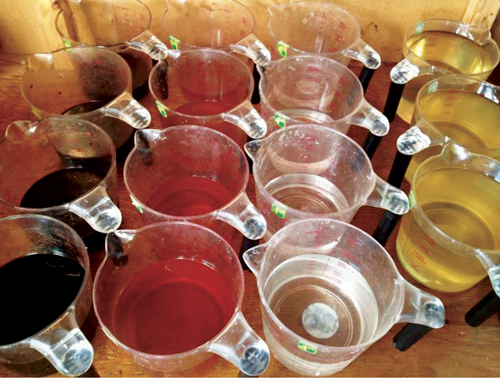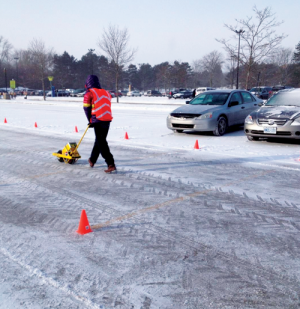September 1, 2014
Research underway:
Snow and ice control in parking lots
Academics and snow pros partner to benefit industry
By S.M. KAMAL HOSSAINProf. Liping Fu and his research team at the University of Waterloo (UW) are near the finish line for their large-scale research project aimed at developing advanced knowledge and practical guidelines on maintenance methods, materials and application rates for winter maintenance of transportation facilities; in particular, parking lots and sidewalks. This research project was initiated by a request from the Snow and Ice Sector Group of Landscape Ontario, recognizing the need for a systematic study to address the common questions facing every winter maintenance contractor: what is the right deicing or anti-icing material, and how much should be applied under a given condition? The project is the first of its kind in North America and has generated significant interest around the world.
Every year, Canada spends over $1 billion to clear snow and ice on public and private roads, parking lots and sidewalks. This includes the use of over 5 million tonnes of salts for deicing and anti-icing operations. Because of these significant financial, environmental, and social implications, considerable research and development efforts have been devoted to the improvement of winter maintenance methods, products, and technologies over the past decades. However, most of the past efforts have focused on roadway maintenance, with little research on parking lots and sidewalks — which account for up to 30 per cent of all salt usage.

Over the course of the research study, more than 5,000 field tests were carried out covering a large number of snow control chemical combinations.
The specific objectives of the project included: determining the condition parameters that affect the performance of rock salts, brines, and alternative chemicals for deicing and anti-icing treatments; determining optimum application forms and rates for deicing and anti-icing treatments of parking lots and sidewalks over a range of pavement and environmental conditions; development of models that can be used to forecast pavement surface conditions, such as residual salts, snow and ice cover, and friction, under specific weather events and treatment schedule; development of guidelines and decision support tools for snow and ice control of parking lots and sidewalks, including material selection, salt application rates and treatment strategies; to synthesise best practices related to parking lot maintenance service policy and standards, material selection and application rates, deicing and anti-icing operations; and finally, to evaluate techniques for collection and processing of large-scale maintenance data collection and performance monitoring.
Real world practices used
To better understand how most parking-lot maintenance contractors operate, small, medium, large maintenance contractors and over 200 municipalities in Canada and the U.S. were surveyed. The primary purpose of the survey was to collect information about the parking lot maintenance industry and current practice. This information was used to help determine the level of service expected for different facilities, the types of materials, the ranges of application rates, and the variety of snow and ice control strategies currently being used.
Multiple data collection sites
The micro testing conducted at the UW parking lot is a semi-controlled experiment, and therefore limited in terms of the kinds of conditions it can cover. To address this limitation, we designed an off-site data collection program with the objective of collecting field data on what maintenance operations being done at some monitored parking lots and how the conditions evolve over time after maintenance operations.

An exhaustive amount of data has been collected for this study using a variety of tools. Here, a 2GO friction tester records the road surface friction after treatment.
An extensive set of field experiments were conducted over the last three winter seasons, including over 5,000 tests covering a large number of treatment combinations in terms of snow control chemicals (e.g., regular salt, magnesium products, Fusion, Snowmelter, etc.), and major maintenance strategies and techniques (e.g., pre-application vs. post-application, pre-wetting vs. dry salt, etc.). While formulating the research methodology, special efforts were made to maximize the realism of the tests as compared to real-world scenarios, including active involvement and inputs from the field professionals and a comprehensive survey of the maintenance industry and the end users. The field tests have resulted in a unique database covering the field performance of various winter maintenance materials and techniques. This performance data has then been rigorously analysed using statistical tools to develop a quantitative understanding of the conditions that influence the effectiveness of various maintenance treatment options, to facilitate the establishment of a set of recommended treatment options and application rates for a wide variety of winter events.
Development of salting model
The data collected by the team of engineers has been processed in an event-by-event and rate-by-rate form. A significant amount of effort was put into the development of snow melting models that relate bare pavement status or amount of snow being melted to salt application rate, as well as environmental factors such as temperature, snow type and amount. The preliminary modeling results show the feasibility of developing such models. Several snow melting models have been developed and used as a basis for developing the optimum salt application rates for particular weather conditions.
The research has so far revealed many interesting findings, some of which have been published in technical papers including three papers in peer-reviewed international journals, 10 papers in international conferences, and updates in past issues of Landscape Trades. The research team is currently working on compiling and summarizing the research results and developing easy-to-use guidelines that can be used by the maintenance industry. These guidelines will be made available at www.sicops.ca before the winter.
A large number of researchers have contributed to the success of this project, including two post-doctoral fellows, four full-time graduate researchers, and over 20 co-op students. This project has been made possible with the financial and logistic support of many organizations from both the government and the private sectors, including Landscape Ontario, GO Transit, Toronto Region Conservation Authority (TRCA), Natural Sciences and Engineering Research Council of Canada (NSERC), Ontario Ministry of Transportation (MTO), Snow and Ice Management Association (SIMA), and a number of private contractors from across Ontario.
S. M. Kamal Hossain is a Ph.D Candidate and Research Assistant in the Innovative Transportation System Solutions Lab at the University of Waterloo.